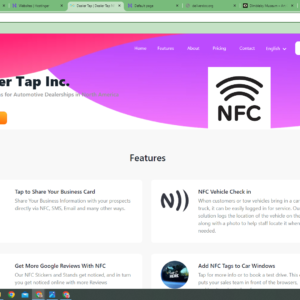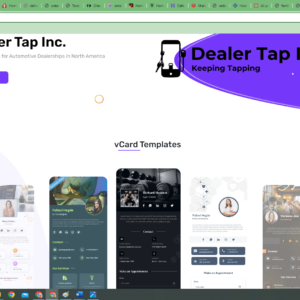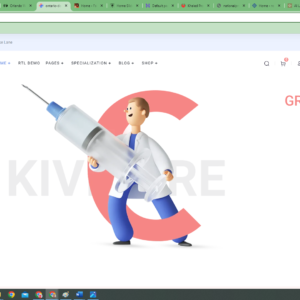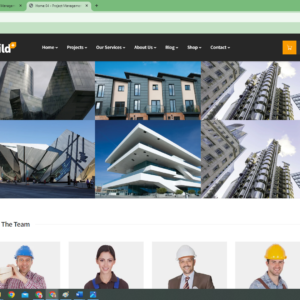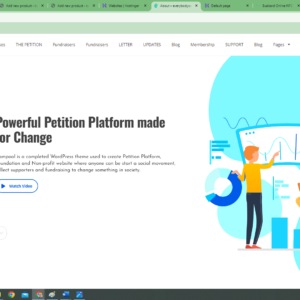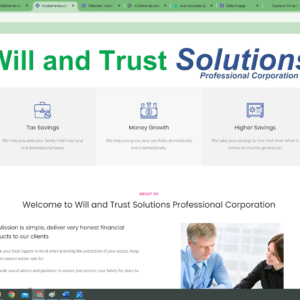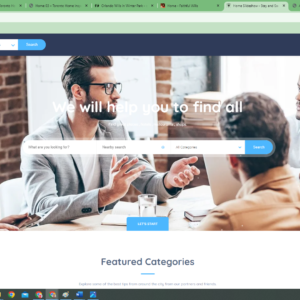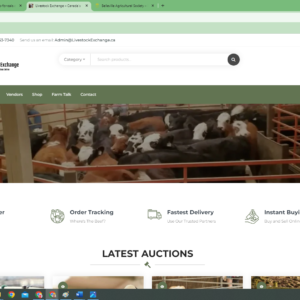Description
“`html
Introduction to NFC Technology in Museums
Near Field Communication (NFC) technology has emerged as a transformative tool for museums and art galleries, offering an array of innovative applications that significantly enhance the visitor experience. NFC technology enables devices to communicate with each other when they are in close proximity, typically within a few centimeters. This capability is harnessed in museums to provide visitors with instant access to a wealth of information, interactive displays, and personalized tours.
One of the primary advantages of NFC technology in museums is its ability to deliver real-time information. By simply tapping their NFC-enabled smartphones against an NFC tag placed near an exhibit, visitors can access detailed descriptions, historical contexts, and multimedia content such as videos and audio guides. This immediacy not only enriches the learning experience but also caters to different learning styles and preferences, making the museum visit more inclusive.
Interactive displays are another significant benefit brought by NFC technology. Museums can create engaging, dynamic exhibits where visitors can interact with the artifacts through their mobile devices. For instance, an NFC-enabled exhibit might allow visitors to view a 3D model of a historical artifact, manipulate it for a closer look, or even participate in an augmented reality experience that brings history to life. These interactive elements make the visit more engaging and memorable, particularly for younger audiences.
Personalized tours are also greatly enhanced by NFC technology. Traditional guided tours can be complemented or even replaced by NFC-based systems that offer custom-tailored experiences. Visitors can select their areas of interest through a museum’s app, which then guides them to specific exhibits and provides relevant information based on their preferences. This personalized approach ensures that each visitor can explore the museum at their own pace and according to their unique interests, further promoting accessibility and enjoyment.
In essence, NFC technology holds the potential to revolutionize how museums operate and interact with their visitors. By leveraging this technology, museums can offer a more inclusive, informative, and engaging experience, thereby broadening their appeal and accessibility to a diverse audience.
The Role of a Museum Consultant in Implementing NFC
A museum consultant specializing in NFC technology plays a pivotal role in transforming how museums engage with their visitors. Their expertise is crucial in assessing the unique needs of each institution, designing tailored NFC solutions, and ensuring effective implementation. By leveraging their deep understanding of both museum operations and advanced technology, these consultants bridge the gap between traditional museum experiences and modern, interactive engagements.
The initial phase of a consultant’s role involves a thorough assessment of the museum’s current state, including visitor demographics, existing technologies, and operational workflows. This assessment allows the consultant to identify areas where NFC technology can significantly enhance visitor experiences. For instance, NFC tags can be used to provide detailed information about exhibits, facilitate interactive tours, and streamline access to additional digital resources.
Once the needs are identified, the museum consultant designs a customized NFC solution that aligns with the museum’s goals and visitor expectations. This includes selecting appropriate NFC hardware, such as tags and readers, and developing user-friendly interfaces that can be easily integrated into the museum’s existing infrastructure. The consultant also ensures that the NFC system is scalable and adaptable to future technological advancements.
Effective implementation is another critical aspect of the consultant’s role. This involves overseeing the installation of NFC devices, conducting staff training sessions, and establishing protocols for maintaining and updating the technology. The consultant works closely with museum staff to ensure a seamless transition and to address any technical issues that may arise during the implementation phase.
Case studies of successful NFC integrations in museums underscore the transformative impact of this technology. For example, the Smithsonian Institution utilized NFC tags to create interactive exhibits that significantly enhanced visitor engagement and accessibility. Similarly, the British Museum implemented NFC-enabled audio guides that offered multilingual support, catering to a diverse international audience.
In summary, a museum consultant specializing in NFC technology is indispensable for museums aiming to modernize their operations and enhance visitor experiences. Their role encompasses a comprehensive assessment of needs, the design of bespoke solutions, and meticulous implementation, ensuring that museums can fully leverage the benefits of NFC technology.
Developing a Website for NFC Consulting Services
Creating a professional website dedicated to providing NFC consulting services for museums is a crucial step in modernizing museum accessibility. The website must be meticulously designed to offer an informative, user-friendly experience that clearly outlines the consulting services available, while also establishing credibility and trust among potential clients.
One of the key features of the website should be a detailed description of the NFC consulting services offered. This section should explain how NFC technology can be integrated into museum operations to enhance visitor engagement and accessibility. Outlining the benefits, such as improved interactive experiences and streamlined information delivery, can help potential clients understand the value of these services. Additionally, detailing the process of implementation, from initial consultation to full deployment, can provide a clear roadmap for museums considering this technology.
Including client testimonials is another essential element. These testimonials can offer insights into the experiences of other museums that have successfully implemented NFC technology with the consultant’s help. Positive feedback from respected institutions can significantly bolster the consulting firm’s credibility and demonstrate proven success, encouraging new clients to engage their services.
Case studies should also be prominently featured on the website. These in-depth analyses of past projects can highlight specific challenges and the innovative solutions provided by the consulting firm. By showcasing before-and-after scenarios, potential clients can gain a better understanding of the tangible benefits NFC technology can bring to their museums.
Finally, the website should have a comprehensive contact information section. This should include multiple ways for potential clients to get in touch, such as a contact form, email address, phone number, and possibly a live chat option. Providing easy access to consultation services can facilitate prompt and effective communication, ensuring that inquiries and requests for quotes are handled efficiently.
Launching an Online Learning Management System
The development of an online Learning Management System (LMS) marks a significant advancement in the field of museum management. This digital platform is designed to provide comprehensive educational resources and specialized training courses aimed at enhancing the skills and knowledge of museum professionals. The LMS’s user-friendly interface ensures ease of navigation, allowing users to seamlessly access a variety of learning materials and courses tailored to their individual needs.
One of the primary features of the LMS is its extensive course offerings, which cover a wide range of topics pertinent to museum management. These courses are meticulously curated to include subjects such as curatorial practices, exhibition design, visitor engagement strategies, and the integration of NFC technology in creating accessible exhibits. Each course is developed by industry experts and offers a blend of theoretical knowledge and practical insights, ensuring that learners can apply what they have learned in real-world scenarios.
The LMS supports continuous professional development by offering both self-paced and instructor-led courses. This flexibility allows museum professionals to engage with the learning material at their own convenience, making it easier for them to balance their educational pursuits with their professional responsibilities. Furthermore, the platform includes interactive elements such as discussion forums, live webinars, and peer collaboration opportunities, fostering a sense of community and enabling knowledge sharing among museum professionals.
Additionally, the LMS tracks learners’ progress through its advanced analytics and reporting features. This functionality provides valuable feedback to both the learners and their institutions, highlighting areas of strength and identifying opportunities for further development. By offering certifications upon course completion, the LMS not only validates the skills acquired but also enhances the career prospects of museum professionals.
In essence, the launch of this online Learning Management System represents a forward-thinking approach to museum management education. By leveraging technology to provide accessible and high-quality training, the LMS plays a crucial role in equipping museum professionals with the expertise needed to navigate the evolving landscape of the museum sector.
Course Overview: Museum Management and NFC Technology
The flagship course, “Museum Management and NFC Technology,” available on our Learning Management System (LMS), is meticulously designed to equip museum professionals with the skills necessary to leverage NFC (Near Field Communication) technology for enhanced operational efficiency and visitor engagement. Priced at $10,000 per user, this comprehensive course integrates theoretical knowledge with practical applications, ensuring that participants are well-versed in both the foundational aspects of museum management and the innovative use of NFC technology.
The curriculum is structured into several key modules, each focusing on a specific aspect of museum management and NFC technology. The introductory module provides an overview of current museum management practices, emphasizing the importance of integrating technology to modernize operations. Subsequent modules delve into the technical aspects of NFC technology, including its implementation, maintenance, and security considerations. Participants will learn how to create interactive exhibits, streamline visitor check-ins, and enhance data collection through NFC-enabled devices.
Learning outcomes of this course are highly targeted. By the end of the program, participants will be proficient in designing and executing strategic plans that incorporate NFC technology to improve visitor experiences. They will be adept at using NFC for inventory management, ensuring that exhibits are accurately tracked and maintained. Additionally, participants will gain insights into how NFC can be used to gather visitor data, allowing for more personalized and engaging museum experiences. The course also covers the legal and ethical considerations of using NFC technology, ensuring that participants are aware of privacy and data protection regulations.
Completing this course offers numerous benefits. Museums that implement the strategies taught will likely see an increase in visitor satisfaction and operational efficiency. NFC technology can make the visitor experience more interactive and engaging, leading to higher visitor retention rates. Moreover, the ability to streamline processes and gather valuable visitor data can significantly enhance decision-making and strategic planning. Overall, this course is an invaluable investment for any museum professional looking to stay ahead in the rapidly evolving landscape of museum management.
Promoting Accessibility and Inclusivity in Museums
Accessibility and inclusivity are fundamental to the modern museum experience, ensuring that all visitors, regardless of their abilities, can engage meaningfully with exhibits. By leveraging NFC technology, museums can significantly enhance their accessibility features, creating an environment where every visitor feels welcome and valued.
NFC technology can be seamlessly integrated into various aspects of the museum experience to support visitors with disabilities. For instance, NFC-enabled audio guides can provide detailed descriptions of exhibits, making them accessible to individuals with visual impairments. Visitors can simply tap their NFC-enabled devices on designated tags to receive audio information, enhancing their understanding and enjoyment of the exhibits.
Tactile exhibits are another excellent example of how museums can cater to visitors with different needs. By embedding NFC tags within these exhibits, museums can offer additional layers of information. For example, a tactile model of a historical artifact can include an NFC tag that, when scanned, provides detailed historical context, background information, or even related multimedia content, thus enriching the visitor’s experience.
Multi-language support is crucial in promoting inclusivity, particularly in museums that attract a diverse, international audience. NFC technology can facilitate this by enabling personalized content delivery. Visitors can select their preferred language on their NFC-enabled devices, which then provide exhibit information, audio guides, and interactive content in the chosen language. This feature ensures that language barriers do not impede the visitor’s engagement with the museum’s offerings.
Moreover, NFC technology can be employed to create tailored experiences for visitors with hearing impairments. Museums can offer sign language guides accessible via NFC tags, ensuring that these visitors receive the same depth of information as their hearing counterparts. Additionally, NFC can support real-time captioning services for live presentations and tours, furthering inclusivity.
In essence, the integration of NFC technology within museums is a powerful tool for promoting accessibility and inclusivity. By implementing features such as audio guides, tactile exhibits, and multi-language support, museums can create an inclusive environment that accommodates all visitors, enhancing their overall experience and ensuring that everyone can fully engage with the cultural and educational offerings on display.
Auctioning the Consultant’s Services and LMS Platform
The upcoming auction of the consultant’s services, alongside the Learning Management System (LMS) platform, presents a unique opportunity for museums to enhance their operational and educational capabilities. The auction will be conducted in a transparent and structured manner, ensuring all interested parties have a fair chance to participate and win. Bidders will be required to register beforehand, providing necessary credentials and agreeing to the auction guidelines. This preparatory step ensures a smooth and efficient bidding process.
Participants can place their bids through an online platform, which will display real-time updates of the highest bids and remaining auction time. The bidding guidelines stipulate incremental increases in bid amounts to maintain a competitive yet fair environment. The highest bidder at the close of the auction will secure the consultant’s services and the LMS platform, promising a comprehensive package aimed at revolutionizing museum management and accessibility.
The winning bid entails not only access to expert consultancy but also the integration of a state-of-the-art LMS platform tailored to museum needs. This platform will facilitate continuous learning and professional development for museum staff, enhancing their ability to create inclusive and engaging visitor experiences. Additionally, the consultant will provide strategic insights and hands-on assistance to optimize the use of the LMS, ensuring it delivers maximum value.
The potential return on investment for the successful bidder is substantial. Implementing NFC technology and a robust LMS platform can significantly improve operational efficiency, visitor satisfaction, and educational outreach. By leveraging expert consultancy, museums can develop innovative strategies to enhance accessibility and engagement, positioning themselves as leaders in the cultural sector. This auction represents a strategic investment in the future of museum management, promising long-term benefits and sustainable growth.
Conclusion: The Future of Museums with NFC Technology
The integration of NFC technology within the museum sector marks a significant leap towards enhancing visitor engagement and operational efficiency. As discussed throughout this blog, NFC solutions offer numerous advantages, from streamlining ticketing processes to providing visitors with interactive, educational experiences. By leveraging NFC-enabled devices, museums can deliver personalized content, ensuring that each visitor’s journey is unique and memorable.
Furthermore, the implementation of NFC technology can aid in asset management, improve security, and provide valuable data analytics, which can be used to better understand visitor behavior and preferences. This data-driven approach allows museums to tailor their exhibits and services to meet the evolving needs of their audience, thereby increasing visitor satisfaction and retention.
Professional consulting and training play a crucial role in the successful adoption of NFC technology in museums. By partnering with experts in the field, museum management can gain the necessary insights and skills to effectively integrate these advanced solutions into their operations. Training programs, both online and offline, equip museum staff with the knowledge to utilize NFC technology to its fullest potential, ensuring a seamless experience for all stakeholders.
As we look towards the future, the potential for NFC technology in museums is boundless. It not only transforms how visitors interact with exhibits but also revolutionizes the behind-the-scenes management of museum resources. Museums that embrace these technological advancements stand to benefit greatly, setting a new standard for accessibility and visitor engagement.
We encourage museum professionals to explore the array of consulting services available and consider participating in specialized training programs. By doing so, they can stay ahead of the curve and ensure their institutions remain at the forefront of innovation. Join us in this exciting journey and be a part of the revolution in museum accessibility and management.


